What is convection in a gas oven and is it needed? Useful tips for housewives on the selection and operation
You already know what convection is in a gas oven, and what amenities are provided to you with this function? Agree that to forget about burnt and baked dishes, entrusting the miracle oven with care about the quality of cooking is a tempting prospect. And gaining with the new function of additional conveniences expands the possibilities of any housewife.
We will talk in more detail about the possibilities, advantages and disadvantages, about how to use convection for our own benefit. We also consider the operating modes, give recommendations for choosing a convection oven.
The content of the article:
Purpose and principle of operation of convection
When cooking, heat is transmitted in several natural ways. By lowering the pan closer to the heating element, by switching the heating power controller or stirring the product, we control the transfer of heat.
Therefore, so that nothing burns out and does not dry out in the oven, the hostess has to intervene several times in the cooking process, releasing heat. Are we passing by many possibilities, leaving the convection process to chance?
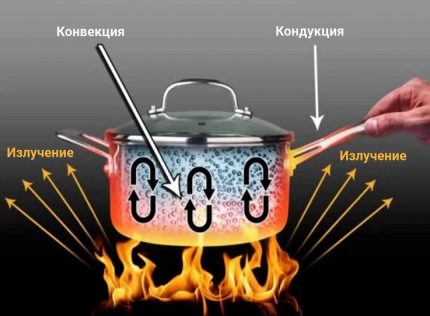
Conventional ovens have a main source of heat in the lower part and the heating of the chamber is due to radiation and natural convection. Due to the heat-inhibiting dishes and the low thermal conductivity of the air itself, a significant temperature difference arises in the chamber volume, which can lead to burning or non-baking. Is it possible to improve the situation?
Equipping the oven with a special fan and exhaust system, the developers added a function forced convection to eliminate temperature differences.Thanks to the improvement, several new features appeared, for example, quick heating of the camera, obtaining a uniformly fried crust, and even saving.
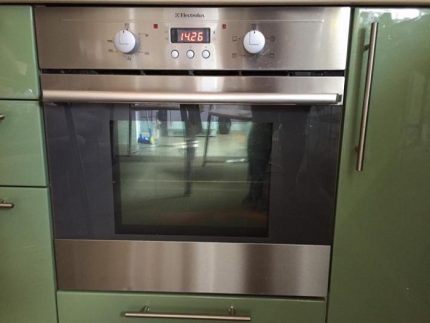
The principle of operation of such an oven is convection. The device uses forced distribution of heated air masses in the chamber volume, as a result of which either uniform heating is achieved, or the creation of zones with specified temperature conditions.
Heat with a given speed is removed from the heating elements by one or more convectors.
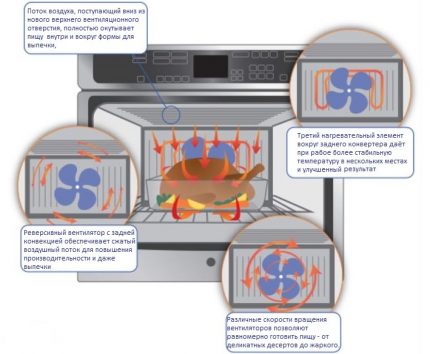
The heating of ordinary (non-convection) and the simplest convection (or traditionally convection) gas ovens (hereinafter referred to as the DG) is carried out by gas burners from below.
There can be several heating elements in a more complex convection type main heater - a gas burner at the bottom, a gas or electric heating element at the top (for grilling), an annular electric heater (CT) around the main fan.
Gas and electric gas convection ovens combined devices.
In most cases, the circulation fan is installed on the back of the oven. Its electric motor can be accessed from the outside of the unit. The impeller blades are inside the chamber and covered with a grill.
Some models also have a removable grease trap. He captures droplets of fat from the air coming from the chamber to the fan, and then the impeller is not so polluted.
Double convection oven models are also available, in which the fans are installed in different places of the chamber and, even, not at the same height. They can work in different modes. With their simultaneous operation, heat is distributed faster and more evenly. If one of them is turned on, zones with different temperatures are formed in the chamber, which allows you to cook dishes that require different conditions.
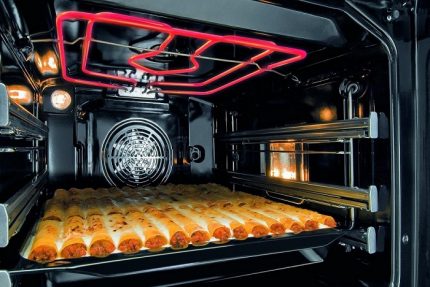
In addition to the fan involved in cooking, in the design of the oven there is an exhaust system with which hot air circulating in the oven is removed. Using the same system, moisture is also removed from the chamber, so this oven is more suitable for baking pizza and vegetables. Due to dehydration, caramelization occurs on the surface of the products with the formation of a delicious crust.
In models with convection function, an internal fan is also installed, which is not visible from the camera side. It is designed to protect against overheating of the sides of the oven, electronic equipment and furniture in the vicinity. The mechanism is activated only at a certain temperature.
Oven owners have the option to enable or disable the convection function as they wish. In the latter case, the oven will work as usual.
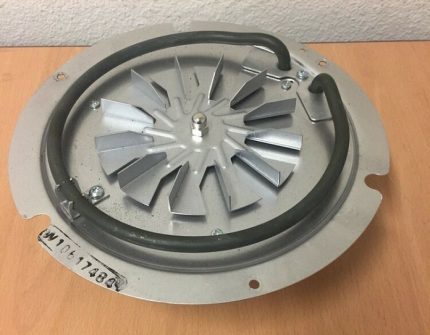
Gas ovens with a convention function have protective systems, therefore they are as safe during operation as electric ones. Flame detectors are installed on the burners, and there are also temperature relays.
Overview of the pros and cons
What are the advantages of convection ovens? Fast cooking - the main advantage. The directed flow of hot air transfers more heat to the food, so food is cooked faster and more evenly. The cooking time for most dishes is about a quarter (25%) less. If you cook according to recipes designed for a conventional oven, do not forget to count the time before setting the timer.
Many culinary specialists note that convection cooking for frying is preferable, since the brown crust on the meat is formed more uniformly under the influence of circulating hot air. Juices remain inside the product, which makes food more tender and tastier.
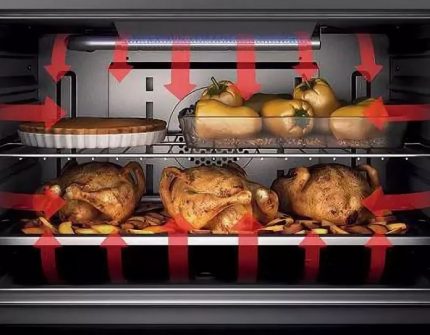
Cooking time reduction - This is a reduction in energy costs, therefore you save money. Reducing the time spent also occurs when several different dishes are being cooked at the same time. Saving energy and time is also achieved because there is no need to often open the oven in order to control the cooking process (when you open the door, the already gained heat is lost). Reduces time and energy for preheating the oven before loading products.
New opportunities are emerging. Add feature cook several dishes at once, mode defrosting and drying at small (up to 40aboutC) or room temperature.
Unfortunately, there were some minuses, the main of which is high price. DG models with convection function are almost half the price of analogues that do not have it. If you cook a lot, often with pleasure, as well as if the purchase of an expensive machine does not cause significant damage to the family budget, such a generous “advance” will not cause regrets afterwards.
Some products do not tolerate blowing during the preparation process, since the air flow is an external force capable of destroying the fine structure formed during the ascent. For example, a "sissy" souffle easily loses its shape, turning into something flat. Even cupcakes can lose their bearing and become sideways. When cooking products that require delicate handling, the convection function is turned off or set to a minimum, slowing the air flow.
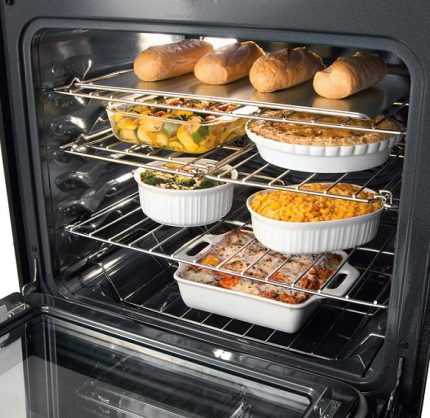
In any case, even if finances are not a weighty argument when choosing an oven, you have to decide whether you need convection in a domestic gas oven or you can do without it yourself.
Having solved the dilemma in favor of the purchase, you can familiarize yourself with information about the operating modes of the ovens, as well as seek advice from a consultant on choosing a particular model.
Convection Modes and Control Panel
The presence in the design of the convector oven ensures its operation in several modes.
Many of the modes listed below are not found in all oven models, so when choosing an oven, you should carefully study the instructions.
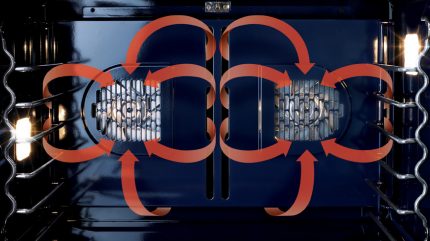
The following are the types of modes in which the convector operates.
- In slow cooking mode the lower gas burner and the fan work simultaneously. The chamber creates a uniform heating of the space. In this mode, large pieces of meat are ideally baked. The mode is also used to warm dishes.
- Convection skewer. Included lower gas burner, rotisserie and fan.Everything is distributed: the spit rotates the product, the fan creates a stream of uniformly enveloping heat. Crisp and juicy meat are provided.
- In pizza mode at the same time, the lower heating element, the annular heating element and the fan are included.
- With double convection The task of creating air circulation is entrusted to two fans. According to the manufacturers, this way sets a particularly even temperature distribution in the oven.
- Blow Grill. Before placing the product, it is recommended to preheat the oven in advance. The fan works together with the top heater, softens the heat and allows you to evenly bake meat on the grill. The mode is good for large pieces of meat and dishes of large thickness.
- Grill turbo - the most energy-consuming mode. Three heating elements and a fan that periodically turns on and off are included. Many products that require intensive cooking are cooked efficiently and quickly at the same time. Smells do not mix (and tastes, too).
- Steam Convection Mode allows you to cook dishes like steam. In this mode, you can cook boiled pork without wrapping it in foil. When using the probe, the recommended temperature is 130 ° C.
- ECO mode Suitable for preparing a large number of products at the same time. The convector, upper and lower heaters are included. Bake cookies and cakes well.
Such a number of new modes, in addition to those that are already known to the mistress of ordinary DGs, may even be confusing at first. But a good habit is developed quickly. Cooking with convection quietly becomes the norm.
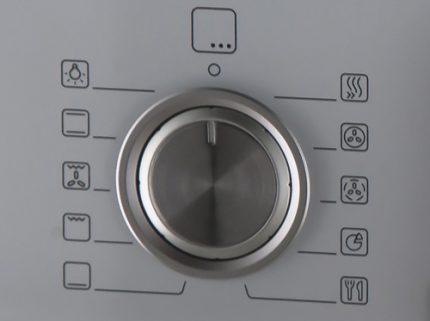
In addition, such equipment is available defrosting - usually indicated by a snowflake. Ventilation without turning on the burner. Blowing air replaces the cold air layers enveloping frozen foods with warmer ones. As a result, an “air coat” does not form around the product and the defrosting process proceeds faster.
Drying mode possible when the convector is on and a temperature of about +50 ° C created by the lower burner.
Another useful option is rapid cooling of the ovenwhat usually happens when the fan is turned on without igniting the gas burner. This mode requires opening the oven door.
In a gas convection oven, as a rule, mechanical control is used. It is simpler and therefore more reliable than the touch or electronic version.
For this, at least two regulators are installed:
- heating temperature setting knob;
- handle for setting the operating mode of the device.
In addition to the "rotary" (mechanical) control, there are models with a rotary-button or rotary-touch control. For example, Corting OGG 771, Bosch HGN 22H350 have a touch electronic timer and rotary thermostat controls.
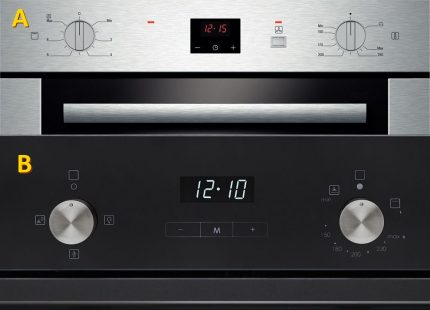
In addition to the handles, the control panel also contains indicators that signal the operation of the device.
Nuances of operation and fan shutdown
In electric ovens, the convection fan is switched on during preheating, even if you are not using convection cooking. About connecting a gas stove with an electric oven, we wrote here.
In gas stoves, it does not turn on during this period. During convection cooking, the convector typically runs for about 10 seconds, then turns off for about 40-60 seconds.The convector duty cycle in different versions may vary, for example, work and rest an equal amount of time.
Ways to turn off the fan
Since there are many different models of convection DHs, the fan shutdown process may vary.
Method # 1 - turn off convection
Turn off convection option. In some oven models, it is possible to disable the convection function. The fan turns off automatically.
Method # 2 - open the door
In many models, the fan switches off immediately when the oven door is opened. It will turn on again when the door closes. To turn off the convector, open the oven door during cooking.
Method # 3 - cool the oven
Turn off the oven and let it cool. During cooling, the fan may remain on for a while. It will eventually shut down.
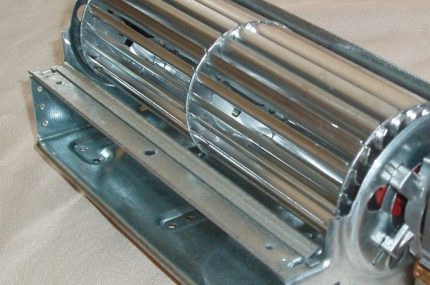
The cooling fan is supposed to work until the stove cools down.
Method # 4 - switch the oven setting
If your oven is combined with a conventional oven, switch the setting to normal operation. If the oven is combined, switching to the normal setting in accordance with the manufacturer's instructions will usually turn off the fan.
Method # 5 - click the button
In addition to the internal fan that transfers heat in the food zone, some convection ovens also have an exhaust fan to remove children, smoke and odors from the work area.
The device can have a control for selecting settings, for example, high, medium or low, or one button that is pressed to turn off or on the hood. To turn off the exhaust fan, press the power off button on the front of the device.
When should I contact a service center?
In general, fans installed in gas ovens are reliable equipment designed for many years.
But there are signs, if any, should immediately contact the service center:
- a creak is heard, extraneous noise, tapping during the operation of the oven;
- the cooling fan never turns on;
- you hear an unpleasant odor or smoke from a washed oven.
Consider the features of these breakdowns in more detail.
Firstly, convectors work not quite noiselessly, but quite quietly. If the fan makes an abnormal sound, for example, a squeal, creak or tapping, especially when it stops or starts, this is an occasion to immediately contact a specialist. If the reversing convector simply pulled in a piece of foil and it is easily removed, then the problem can be fixed on its own.
Secondly, usually the cooling fan is not visible, but you will hear its work. When the electronics heat up, it will turn on; when the electronics have cooled down, it will turn off. An oven or hob creates enough heat to turn on the cooling fan. If the cooling fan never turns on or off, you should visit a service center.

Installation and Operation Safety
All models of gas ovens have several systems that ensure safe operation. So, the door glazing is laminated so that the burning temperature does not reach the outer surface of the door. So that even a child looking at the “porthole” of a chicken rotating on a spit will not get a burn. He will not be able to participate in controlling the oven and open the door, thanks to the lock.
In addition, as mentioned above, heat is removed from the surface of the oven by an internal electric fan.
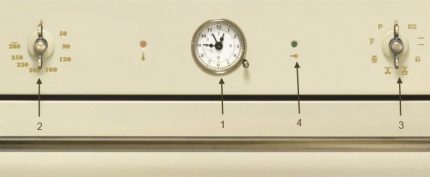
The gas supply is automatically blocked if:
- accidentally burns out the burner;
- a gas leak occurs;
- the pressure in the gas line drops.
For oven settingsworking on gas, it is necessary to invite a specialist. He will not only safely connect the gas, but also check the compliance of the technical device with the type of gas (natural or liquefied) and, if necessary, replace the nozzle.
Additionally necessary install exhaust equipment. To connect to the electric network and gas, you need to contact specialists.
The electrical outlet must be of the appropriate type and must be earthed. In addition to the above, measures must be taken to ensure free access to the air oven and its removal. Therefore important link_webnavoz] prepare the place correctly [/ link_webnavoz].
Features of the use of equipment
It sometimes happens that an acquired convection oven is not used in convection mode. It would seem that such an excellent function should attract any housewife and be used one hundred percent. In fact, this is not happening yet. The main reason is ignorance of the advantages and features of the function, and the need to make efforts to master it.
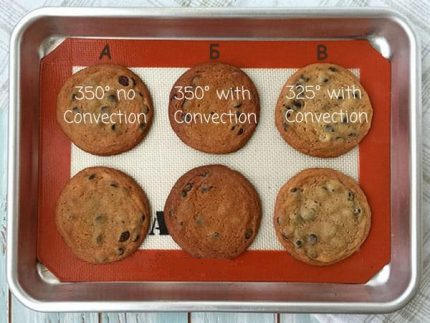
The difficulty is that for cooking in convection mode, different periods are needed. Cooking time in convection mode is a quarter less, with the exception of baking products in closed form - in foil or sleeve.
Therefore, almost all recipes need to be transformed - you need to reduce the baking time by 25%. The same can be achieved by lowering the cooking temperature by a quarter. Not all housewives are ready for these innovations (to work with translation and get used to cooking in a new way).
To solve the problem and help the owners of modern ovens, manufacturers went in several ways:
- recounted the terms of preparation of the main products and provided information in the instructions;
- participated in the release of cookbooks with a recipe for convection devices;
- Ovens have been programmed to automatically set the time / temperature when the convection function is turned on.
Unfortunately, gas ovens are not endowed with such capabilities (automatic translation) yet. Perhaps the situation will be corrected in the near future. But instructions, books and the Internet are accessible to any housewife.
Convection Oven Tips
The choice of an expensive technical device is best done in a specialized store. Here you can get timely advice, purchase goods of guaranteed quality.
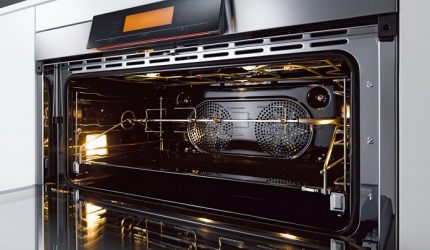
What is important to consider when choosing:
- Ovens are dependent (come complete with a hob, have a common control panel) and independent (installed separately). In the first case, choosing a compatible DG and a separate hob can be a daunting task. Independent ovens can be located in the kitchen anywhere and can be easily combined with any hob.
- The hostess's capabilities depend on the number of heating elements and fans in the design. More elements - more modes.
- Noteworthy additional features and security systems.For example, the presence of blockage from child intervention.
- A weighty argument in favor of choosing a particular model is the availability of a service in your city.
- The choice of model for aesthetic reasons also takes place. Fortunately, leading companies produce equipment in more than one style or color scheme.
The cleaning method is another significant parameter. Unfortunately, gas ovens are cleaned in the traditional way.
When choosing an oven, we recommend that you first of all turn to the products of manufacturers whose equipment has already been recognized as benign, reliable and trouble-free.
Conclusions and useful video on the topic
Useful information for housewives about the operation of the oven with convection. It is clear, understandable, and most importantly, the processes are explained and the nuances are shown.
A short tour of the choice of ovens.
Choosing between a conventional and convection oven, the buyer weighs his capabilities and desires. The purchase of an oven even with a pair of convection modes gives the hostess a chance to become a master of the virtuoso use of the opportunities provided by convection, and to reward herself and the household with amazing dishes.
Want to talk about your personal experience in choosing a convection oven and the features of its use in the preparation of various dishes? Or do you think buying such a gas oven is just a marketing ploy? Express your opinion on this issue, provide weighty arguments “for and against” the acquisition of gas equipment with convection - the comment form is located below.

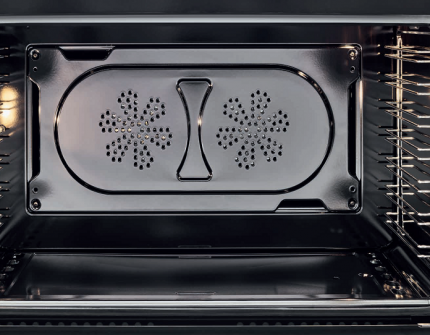
 How to turn on the oven in a gas stove: recommendations for igniting gas in the oven and an overview of safety rules
How to turn on the oven in a gas stove: recommendations for igniting gas in the oven and an overview of safety rules 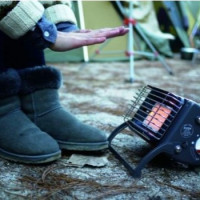 Rating of gas stoves for a tent: ten of the best burners and heaters + tips for choosing
Rating of gas stoves for a tent: ten of the best burners and heaters + tips for choosing 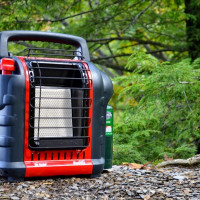 Rating of the best compact gas heaters: TOP-10 models and tips for customers to choose
Rating of the best compact gas heaters: TOP-10 models and tips for customers to choose 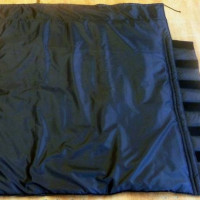 How does a thermal blanket work for gas cylinders: features of the device and use + selection tips
How does a thermal blanket work for gas cylinders: features of the device and use + selection tips 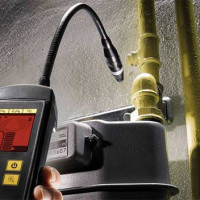 The 10 best handheld portable gas analyzers: an overview of the best deals and selection tips
The 10 best handheld portable gas analyzers: an overview of the best deals and selection tips  Gas pipe plug: varieties, selection tips and installation details
Gas pipe plug: varieties, selection tips and installation details  How much does it cost to connect gas to a private house: the price of organizing gas supply
How much does it cost to connect gas to a private house: the price of organizing gas supply  The best washing machines with dryer: model rating and customer tips
The best washing machines with dryer: model rating and customer tips  What is the color temperature of light and the nuances of choosing the temperature of the lamps to suit your needs
What is the color temperature of light and the nuances of choosing the temperature of the lamps to suit your needs  Replacement of a geyser in an apartment: replacement paperwork + basic norms and requirements
Replacement of a geyser in an apartment: replacement paperwork + basic norms and requirements